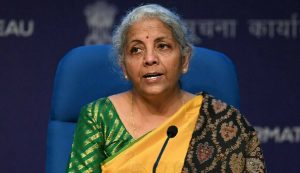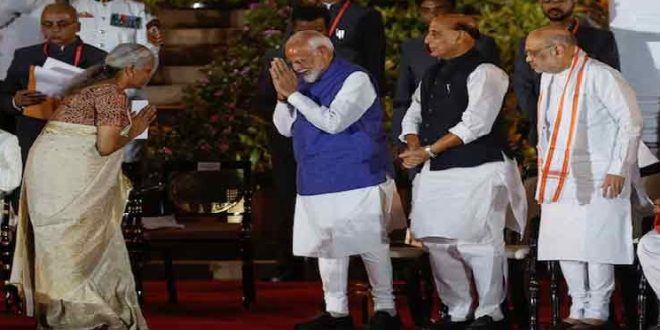24-07-2024
Bureau Report + Agencies
NEW DELHI: India unveiled spending of billions of dollars to create new jobs and satisfy key coalition partners in the first budget by Prime Minister Narendra Modi’s government after an election setback, aiming to win back voters and retain political support.
Among a host of tax changes were an increased levy on equity investments to allay concerns of an overheating market, but also lower taxes for foreign companies, in a bid to lure investment.
 The outlays included $32 billion for rural programs, spending of $24 billion over five years to create jobs, and more than $5 billion for two states ruled by coalition partners, Finance Minister Nirmala Sitharaman said on Tuesday.
The outlays included $32 billion for rural programs, spending of $24 billion over five years to create jobs, and more than $5 billion for two states ruled by coalition partners, Finance Minister Nirmala Sitharaman said on Tuesday.
“In this budget, we particularly focus on employment, skilling, small businesses, and the middle class,” she said, adding that subsequent budgets would build on these focus areas.
Despite the new spending, India cut its fiscal deficit target to 4.9% of gross domestic product in 2024-25, from 5.1% in February’s interim budget, helped by a large surplus of $25 billion from the central bank.
The government marginally reduced gross market borrowing to 14.01 trillion rupees.
Analysts had blamed distress in rural areas and a weak job market for a poor poll showing that cost Modi’s Bharatiya Janata Party (BJP) its absolute majority.
“The budget successfully engineered a fine balance between supporting job creation and skilling, rural development and agriculture … without compromising on fiscal consolidation,” said Sakshi Gupta, principal economist at HDFC Bank.
The government will also push reforms across factors of production, including land and labour, said Sitharaman, presenting her seventh consecutive budget.
An economic policy framework to “set the scope of the next generation of reforms” will pave the way for job opportunities and sustain high growth, she said.
 Economists have said land and labour reforms are essential to make sure India maintains its fast growth rate. In the last fiscal year, India grew by 8.2%. The government expects it to grow between 6.5%-7% this fiscal year, a report showed on Monday.
Economists have said land and labour reforms are essential to make sure India maintains its fast growth rate. In the last fiscal year, India grew by 8.2%. The government expects it to grow between 6.5%-7% this fiscal year, a report showed on Monday.
The budget showed a nominal growth rate, which includes inflation, of 10.5%, which it said was “slightly conservative”.
However, pushing through bigger reforms will be “challenging” for a coalition government, Gene Fang, associate managing director for sovereign risk at Moody’s Ratings, told Reuters.
Other measures on employment include incentives for companies, such as those in manufacturing, and programs to improve skills and hand out cheaper loans for higher education, Sitharaman said.
India’s official unemployment rate in urban areas is 6.7%, but private agency the Centre For Monitoring Indian Economy pegs it higher, at 8.4%.
The government will also maintain spending on long-term infrastructure projects at 11.11 trillion rupees, offering long-term loans of 1.5 trillion rupees to states to fund such expenditure.
Some of these loans will be linked to reform milestones in areas such as land and labour, which Sitharaman said the government intended to push in its third term.
In a concession to the government’s allies, Sitharaman said it would hasten loans from multilateral agencies for the eastern state of Bihar and the southern state of Andhra Pradesh.
 Pressmediaofindia
Pressmediaofindia




